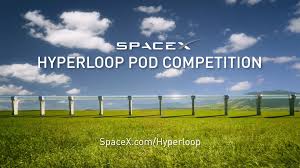It’s one thing to try and design a vehicle to travel on SpaceX founder Elon Musk’s proposed Hyperloop transportation system. It’s another to try and explain how it all works on live television in just a few minutes. Rather than make viewers struggle to imagine what that future will look like, Nicolas Achkarian managed it by using a visual metaphor from the past.
 “It’s like those old tubes in mailrooms that would shoot mail up to a different location,” he explained in an interview with CTV Newschannel a few months ago. The difference, he added, is that pods racing through the Hyperloop might reach speeds of more to 700 miles per hour.
“It’s like those old tubes in mailrooms that would shoot mail up to a different location,” he explained in an interview with CTV Newschannel a few months ago. The difference, he added, is that pods racing through the Hyperloop might reach speeds of more to 700 miles per hour.
Achkarian is the team lead for “Waterloop,” the group that was among those advancing in a Hyperloop pod design competition at Texas A&M University that was held at the end of January. The idea behind the competition is to show that SpaceX’s Hyperloop, which was first proposed almost three years ago, is a viable idea that will engage some of the world’s brightest minds.
“The whole process is to make a detailed design of what we are going to build, with features like the price and all the different physical interactions in the tube,” he said.
Interestingly, Achkarian is not an engineering student himself but has been pursuing studies in both computer science and finance. The latter subject has already proven to be helpful in getting the Waterloo team’s Hyperloop project off the ground.
“One of the concepts that comes up often (in finance) is the notion of a circle of competence. It’s about knowing what you know and what you don’t know,” he says. “I know that I don’t know anything about fluid dynamics and introductory physics. My job is not to design what I think it should be, but to make sure we get it done, get it out there and that we win.”
The team’s concept includes of a few key technologies and physical principals that will allow for a smooth, comfortable and safe flight. To promote a frictionless environment, the pod designed by their team makes use of air caster technology. Effectively, this method of hovering uses a cushion of high pressure air to keep the pod off of the ground. However, the most important element of the design is based around the safety of bringing the pod to a comfortable stop. For this reason, the design integrates a two stage, fail-safe braking system. The physical principals include passive magnetic braking, utilizing eddy currents, and friction braking, ultimately used for bring the pod to a final rest.

“It started with me just reading through the design requirements and looking at all the different sub-systems and splitting them up, putting (team members) in charge,” he said. “We realized that the basic shape was negligible on the performance because it was in a near vacuum.”
The team is now raising fundsfor the build phase of the project. They are actively looking for sponsors for the project. Beyond being recognized as a winner in the competition, Achkarian says he’s also particularly proud of how well working on a Hyperloop pod demonstrated the collaborative ethos of students and faculty at the University of Waterloo.
“We’ve done a lot of this in less than half a year, with very little team member churn,” he said. “When you have that high retention rate, it tells you you’re doing something right.”
Though construction on the Hyperloop won’t begin until later this year, Achkarian says just stimulating the public’s collective imagination should be considered a major SpaceX achievement.
“As with anything involving Elon Musk, it just inspires a lot of optimism in young engineers,” Achkarian explains. “In so many other areas you’re just seeing the same iteration of a product, or just marginally better. When you look at the Hyperloop, you’re looking at something substantially different.”





